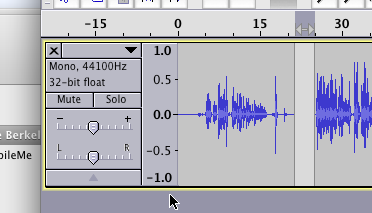
Once I've got the order set, I can burn them to CD or use a file instead (maybe you'd rather play it through the computer hooked into the sound system.) Once I've got all my songs prepared, I can order them to match the order they will be played. This way, I've converting six tracks into one.

In this case, I like to insert each track into audacity after the end of the previous file. In the case of more advanced split track recordings, the songs can be split up into separate tracks. Export to lossless format under the File menu.

Play the file again and make sure it sounds clear and correct out of both speakers/headphones.ĩ. On the new track, select the small down arrow and set the new track to the correct left/right channel.Ĩ. Highlight the remaining channel (Edit-> Select-> All) and then pick "Duplicate."ħ. Retry with the other channel if necessary.Ħ. Play the file and make sure you've muted the correct channel. Mute the channel you think has the vocals.Ĥ. If not, right-click over the channel and pick "split stereo track."ģ. Open up the file and you’ll see two rows one row for each channel. Burn the CD track to a stereo file in a lossless format.Ģ. Using a stereo channel on your mixer, you can use the panning knob to pan out the channel with the vocals. Singers love these because they can hear how the song should sound and then sing to just the instruments. Following the simple steps I use, you can simplify your audio work.Ī split track is simply a stereo audio track in which the left or right channel has something the other does not. I also don't like using a split track for a big event. This isn’t to say that mp3 and the like won’t work, just that lossless audio works much better.The choir director drops a couple CD's and a track listing in your lap and says, "We’re using these split tracks for the Christmas service." Personally, I don't like skipping around from song to song on a CD during a performance. In HTG Explains: What Are the Differences Between All Those Audio Formats?, we went over different lossless and lossy formats, so make sure you start from a lossless audio file for best results. One of the most well known adages of audio editing is “garbage in equals garbage out.” If you start with CD audio and work from there, the end result will be cleaner and clearer than if you start with a compressed mp3. On the whole, however this process works really well if you start with good quality audio. Songs with a lot of vocal effects may end up being mangled by the process, and songs with reverb may leave an echo despite vocals being gone. These kinds of tracks usually work well because the vocals are left evenly balanced between the two channels and that makes them easier to remove accurately. Primus often has extremely unbalanced channels. This cancels out the vocals but leaves the rest in tact. Usually the vocals are put dead center, so we can split the stereo track and invert one channel. Sometimes the bass is pushed more towards the right channel, rhythm guitar might be found more towards the left, and so on.

Vocals are normally placed in the “center channel.” Stereo tracks have two channels, but not all of the instruments are balanced evenly.


 0 kommentar(er)
0 kommentar(er)
